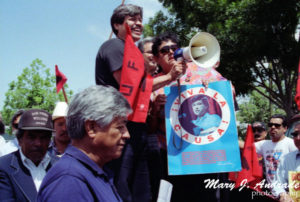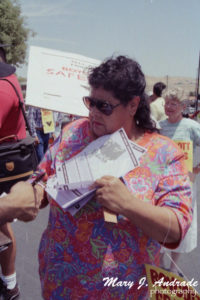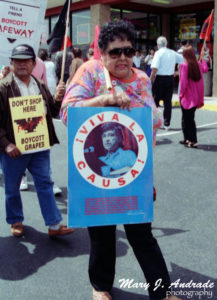
Ernestina Z. García fue defensora de los derechos de los latinos, quien a través de varias décadas de compromiso cívico consiguió realizar cambios en beneficio de la comunidad del Área de la Bahía.
Ernestina nació en Tolleson, Arizona el 19 de mayo de 1929. Ella fue una de los diecisiete hijos de Francisco y Trinidad Arce Zamora, quienes trajeron a su familia a California, en busca de mejores oportunidades de trabajo, estableciéndose en la población de Decoto, la que luego se anexó a Union City.
Ernestina contrajo matrimonio en 1951 con Antonio S. García, con quien procreó cinco hijos. La familia vivió en Oakland hasta 1967 cuando cambiaron de residencia a Milpitas.
La entrega de Ernestina como activista comenzó en 1968. A partir de ese año hizo oír su voz de protesta en defensa de los asuntos que afectaban a la comunidad chicana a nivel educativo, político y económico.
Fue una de las fundadoras de la Confederación de la Raza Unida, una organización que promovía los derechos civiles de salud, vivienda y educación para los trabajadores del campo, estudiantes y personas mayores de origen méxico-americano.

Su hija Doreen Nevel comentaba que aunque su madre fue solamente hasta el octavo grado en su educación, “ella estaba muy informada de los asuntos comunitarios. Yo diría que mi madre tuvo un doctorado en la forma de organizar a la comunidad. Fue a través de su corazón y su mente que pudo tomar a su cargo los asuntos sociales que nos afectan”.
Entrevisté por teléfono a Ernestina. La revista “México Desconocido” me asignó que escribiera un artículo sobre la celebración del Cinco de Mayo en San José. Ernestina me concedió generosamente su tiempo para conversar sobre el papel que desempeñó La Confederación de la Raza Unida en la organización y celebración del Cinco de Mayo en San José, a fines de los sesenta y comienzo de los años setenta.
Justa en su relación con los demás y en dar el crédito a quien se lo merecía, para Ernestina fue de primordial importancia que en dicho artículo mencionara a Jack Ibarra, Raquel Silva, Jack Brito, Angie Coronado, José Carrasco, Humberto Garza y Robert Gonzales, como personas que igualmente mantuvieron muy en alto su compromiso de trabajo para mejorar las condiciones de los latinos. Ella insistió en que no dejara de poner sus nombres, llamándome por dos ocasiones para estar segura de lo que había hecho y para ofrecerme, al mismo tiempo, otros datos sobre asuntos relacionados con la comunidad en general. © La Oferta Newspaper.
Reflections on the Era of Chicanismo and La Revolución
By Elena E. Robles
 There was living history in the room at CET’s Vine Street facility on Saturday, August 27th. About fifty of San Jose’s rowdiest Chicano activists and their families from the 60’s and 1970’s came together in memory of one of their own: Ernestina Zamora de Garcia.
There was living history in the room at CET’s Vine Street facility on Saturday, August 27th. About fifty of San Jose’s rowdiest Chicano activists and their families from the 60’s and 1970’s came together in memory of one of their own: Ernestina Zamora de Garcia.
“Ernie” died on July 3rd at 76 years of age. The memorial celebration was hosted by a group of old friends. “Its too bad that it’s always a funeral that brings us together,” commented Father Jose Rubio. “May this loss be the beginning that we would be closer,” he continued.
The mood was bittersweet and the room was filled with laughter as attendees remembered Ernestina’s (and their own) antics with politicians and police during the civil rights movement of the 1960’s and into the affirmative action years of the 1970’s.
“There should have been more people here,” said Luis Angel Viniegra; a “Black Beret por la Justicia,” by self-description. “She helped change a lot of injustices for a lot of people; and not just for Latinos.”
One of her daughters remembered Ernestina saying on a few occasions: “I wouldn’t have wanted to live without disturbing someone!” People nodded, laughed, and took turns to reminisce at the microphone. Another daughter added, “She always felt that as long as there was poverty, there was a need for revolution.”
Several veteran corridistas such as Noe Montoya, Adrian Vargas, Eduardo Salinas, and Ben Cadena, joined together for a musical homage to Ernestina and what she symbolized to so many of the people in the room. They sang farm worker Chicano classics like “Picket Sign” and “Brown-eyed Children of the Sun.”
Media personality Yolanda Perez, explained: “I visited her not long before she died and her files are filled with history. I wanted to make a documentary film on her life.” Yolanda was one of the original members of Flor del Pueblo, who sang the farm worker movement songs and made them famous from the backs of flatbed trucks and sides of dusty fields during Cesar Chavez’s early years forming his workers‚ union. She dedicated the song “La Mujer está con la Revolución” (The Woman is with the Revolution). Flor del Pueblo is being featured in a Smithsonian Institute musical CD release next year.
“You don’t need to be afraid when right‚ is on your side,” said Shirley Trevino, an early president of the Raza Unida political party and, along with other activists like Bea Robinson, Rachel Silva and Francis Escalante, a participant in the formative years of San Jose’s Chicano movement. “Ernie was fearless,” Shirley added.
“None of us are getting any younger,” laughed one of Ernestina’s long time community action buddies, Henry Dominguez at the microphone. “But I always say: No sabes a dónde vas, si no sabes de dónde vienes‚ (You can’t tell where you are going if you don’t know where you have been).”
After much reflection about the passing of time, graying hair, and past “battles for justice” Henry added, “We all have gifts and we have to look to the upcoming generation,” to pass them on.
¡Que Viva la Raza!
¡Que siga la Familia del Movimiento!
